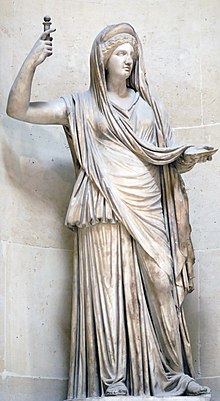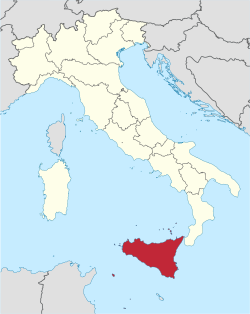|
Greek city of
Thermai Himeraiai in
Sicily
Silver Litra 12mm (0.75 grams) Struck circa 350 B.C.
Reference: HGC 2, 1614
Rare R1
;
Jenkins 1971, p. 72, no. 7
ΘΕΡΜΙΤΑΝ, Head of Hera right, wearing stephanos
ornamented with honeysuckle; monogram to left.
Hercules seated left on rock draped with lion skin, holding club; bow to right.
The refugees from Himera were permitted by the Carthaginians to found a new
settlement at the hot springs not far from the the old city.
You are bidding on the exact item pictured,
provided with a Certificate of Authenticity and Lifetime Guarantee of
Authenticity.

Hera
is the wife and one of three sisters of
Zeus in the
Olympian pantheon
of
Greek mythology
and
religion
. Her chief function is as the goddess
of women and marriage. Her counterpart in the
religion of ancient Rome
was
Juno
. The
cow
,
lion and the
peacock
are sacred to her. Hera’s mother is
Rhea
and her father
Cronus
.
Portrayed as majestic and solemn, often enthroned, and crowned with the
polos
(a high cylindrical crown worn by
several of the Great Goddesses
), Hera may bear a
pomegranate
in her hand, emblem of fertile
blood and death and a substitute for the narcotic capsule of the
opium
poppy. A scholar of Greek mythology
Walter Burkert
writes in Greek Religion,
"Nevertheless, there are memories of an earlier aniconic representation, as a
pillar in Argos and as a plank in Samos."
Hera was known for her jealous and vengeful nature, most notably against
Zeus’s lovers and offspring, but also against mortals who crossed her, such as
Pelias
.
Paris
offended her by choosing
Aphrodite
as the most beautiful goddess,
earning Hera’s hatred.
Hercules is the Roman name for the Greek
divine
hero Heracles
, who was the son of
Zeus (Roman equivalent
Jupiter
) and the mortal
Alcmene
. In
classical mythology
, Hercules is famous for his
strength and for his numerous far-ranging adventures.

The
Romans adapted the Greek hero’s iconography and myths for their literature and
art under the name Hercules. In later
Western art
and literature and in
popular culture
, Hercules is more
commonly used than Heracles as the name of the hero. Hercules was a
multifaceted figure with contradictory characteristics, which enabled later
artists and writers to pick and choose how to represent him. This article
provides an introduction to representations of Hercules in the
later tradition
.
Labors of Hercules
Hercules is known for his many adventures, which took him to the far reaches
of the
Greco-Roman world
. One cycle of these
adventures became
canonical
as the "Twelve Labours," but the list
has variations. One traditional order of the labours is found in the
Bibliotheca
as follows:
- Slay the
Nemean Lion
.
- Slay the nine-headed
Lernaean Hydra
.
- Capture the
Golden Hind of Artemis
.
- Capture the
Erymanthian Boar
.
- Clean the Augean
stables in a single day.
- Slay the
Stymphalian Birds
.
- Capture the
Cretan Bull
.
- Steal the
Mares of Diomedes
.
- Obtain the girdle of
Hippolyta
, Queen of the
Amazons
.
- Obtain the cattle of the monster
Geryon
.
- Steal the apples of the
Hesperides
.
- Capture and bring back
Cerberus
.
The Latin
name Hercules was borrowed through
Etruscan
, where it is represented variously as
Heracle
, Hercle, and other forms. Hercules was
a favorite subject for
Etruscan art
, and appears often on
bronze mirrors
. The Etruscan form Herceler
derives from the Greek Heracles via
syncope
. A mild oath invoking Hercules (Hercule!
or Mehercle!) was a common
interjection
in
Classical Latin
.

Baby Hercules strangling a
snake
sent to
kill him in his
cradle
(Roman marble, 2nd century CE)
Hercules had a number of
myths
that were distinctly Roman. One of these
is Hercules’ defeat of
Cacus
, who was terrorizing the countryside of
Rome. The hero was associated with the
Aventine Hill
through his son
Aventinus
.
Mark Antony
considered him a personal patron
god, as did the emperor
Commodus
. Hercules received various forms of
religious veneration
, including as a
deity concerned with children and childbirth
,
in part because of myths about his precocious infancy, and in part because he
fathered countless children. Roman brides wore a special belt tied with the "knot
of Hercules", which was supposed to be hard to untie. The comic
playwright Plautus
presents the myth of Hercules’
conception as a sex comedy in his play
Amphitryon
;
Seneca
wrote the tragedy Hercules Furens
about his bout with madness. During the
Roman Imperial era
, Hercules was worshipped
locally from Hispania
through
Gaul.
Medieval mythography
After the Roman Empire became
Christianized
, mythological narratives were
often reinterpreted as
allegory
, influenced by the philosophy of
late antiquity
. In the 4th century,
Servius
had described Hercules’ return from the
underworld as representing his ability to overcome earthly desires and vices, or
the earth itself as a consumer of bodies. In medieval mythography, Hercules was
one of the heroes seen as a strong role model who demonstrated both valor and
wisdom, with the monsters he battles as moral obstacles. One
glossator
noted that when
Hercules became a constellation
, he showed that
strength was necessary to gain entrance to Heaven.
Medieval mythography was written almost entirely in Latin, and original Greek
texts were little used as sources for Hercules’ myths.
Renaissance
mythography
The Renaissance
and the invention of the
printing press
brought a renewed interest in
and publication of Greek literature. Renaissance mythography drew more
extensively on the Greek tradition of Heracles, typically under the Romanized
name Hercules, or the alternate name
Alcides
. In a chapter of his book
Mythologiae (1567), the influential mythographer
Natale Conti
collected and summarized an
extensive range of myths concerning the birth, adventures, and death of the hero
under his Roman name Hercules. Conti begins his lengthy chapter on Hercules with
an overview description that continues the moralizing impulse of the Middle
Ages:
Hercules, who subdued and destroyed monsters, bandits, and criminals, was
justly famous and renowned for his great courage. His great and glorious
reputation was worldwide, and so firmly entrenched that he’ll always be
remembered. In fact the ancients honored him with his own temples, altars,
ceremonies, and priests. But it was his wisdom and great soul that earned
those honors; noble blood, physical strength, and political power just
aren’t good enough.
Sicily (Italian:
Sicilia
[siˈtʃiːlja]
) is the
largest island
in the
Mediterranean Sea
; along with surrounding minor
islands, it constitutes an
autonomous region
of
Italy
, and it is officially referred to as
Regione Siciliana (Sicilian Region).

Sicily
is located in the central Mediterranean. It extends from the tip of the
Apennine peninsula
, from which it is separated
only by the narrow
Strait of Messina
, towards the North African
coast. Its most prominent landmark is
Mount Etna
, which, at 3,350 m (10,990 ft), is
the tallest active
volcano
in Europe and one of the most active in
the world. The island has a typical
Mediterranean climate
.
The earliest
archeological evidence
of human dwelling on the
island dates from as early as 8000 BC. At around 750 BC, Sicily was host to a
number of Phoenician
and
Greek colonies
, and for the next 600 years, it
was the site of the
Greek–Punic
and
Roman–Punic wars
, which ended with the
Roman
destruction
of
Carthage
. After the fall of the
Roman Empire
in the 5th century AD, Sicily
frequently changed hands, and during the early Middle Ages, it was ruled in turn
by the Vandals
,
Ostrogoths
,
Byzantines
,
Arabs
and
Normans
. Later on, the
Kingdom of Sicily
lasted between 1130 and 1816,
first subordinated to the crowns of
Aragon
,
Spain
, and the
Holy Roman Empire
, and then finally unified
under the
Bourbons
with
Naples
, as the
Kingdom of the Two Sicilies
. Following the
Expedition of the Thousand
, a
Giuseppe Garibaldi
-led revolt during the
Italian Unification
process and a plebiscite,
it became part of Italy in 1860. After the
birth of the Italian Republic
in 1946, Sicily
was given special status as an autonomous region.
Sicily has a rich and unique culture, especially with regard to the
arts
,
music
,
literature
,
cuisine
and
architecture
. It also holds importance for
archeological
and ancient sites such as the
Necropolis of Pantalica
, the
Valley of the Temples
and
Selinunte
.
The term "Sicily" is believed to derive from the radix sik, term of
Indo-Germanic origin that denotes enlargement and growth, and from the
suffix -ilia (land). In the Greek language the radix sik is used to
identify certain fruits that grow rapidly as the fig tree (sikè) or
pumpkin (sikùs). So Sicily would mean "the land of fertility, fertility
island".
|












